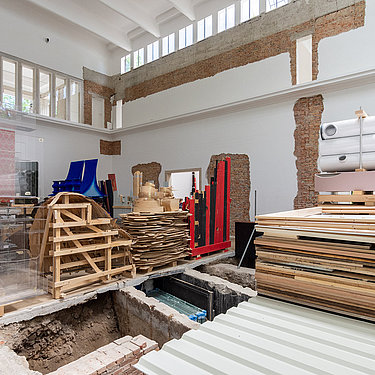Don't miss it! Five highlights at the 18th Venice Architecture Biennale
3 min read1. The Laboratory of the Future
Main Pavilion, Giardini
Usually I always put off visiting the main pavilion of the Architecture Biennale until the last minute, rush through it at breakneck speed, and then I'm completely beat, and a short time later I can hardly remember what I saw. This year I urgently wanted to do that differently and therefore deliberately went first to the exhibition "The Laboratory of the Future" curated by Lesley Lokko.
In the main pavilion in the Giardini, one encounters the "Force Majeure" invited by Lokko, these are 16 architectural positions from the African and diasporic context. The contributions come, among others, from the Pritzker Prize winner Diébédo Francis Kéré, born in Burkina Faso, the Nigerien architect Mariam Issoufou Kamara (atelier masōmī) and the architects Sumayya Vally and Moad Musbahi, practicing in South Africa. The delicate, glowing red installation in the entrance area of the pavilion is particularly memorable.
2. Open for Maintenance
German Pavilion, Giardini
The German contribution "Open for Maintenance - Wegen Umbau geöffnet", curated by the team around ARCH+ / SUMMACUMFEMMER / BÜRO JULIANE GREB (Anne Femmer, Franziska Gödicke, Juliane Greb, Christian Hiller, Petter Krag, Melissa Makele, Anh-Linh Ngo, Florian Summa), is dedicated to the themes of care, repair and maintenance. Arriving at the German Pavilion, I am briefly irritated when I see the ramp in front of the pavilion and have to think for a moment whether it is part of this year's intervention or not.
The wooden component is so cleverly adapted to the classicist building that you would think it had always been there. The ramp now provides barrier-free access to the German Pavilion, which will be used as a materials storage facility and workshop by numerous international institutions and universities from May to November. The materials stored in the pavilion for the 1:1 Maintenance workshop program come from the demolition remains of the 2022 Art Biennale and point to the waste of resources in the biennial context.
3. Joar Nango – Girjegumpi: The Sámi Architecture Library
Nordic Pavilion, Giardini
As is well known, the Nordic Pavilion by Sverre Fehn is the architectural highlight in the Giardini. This year it hosts the exhibition "Girjegumpi - The Sámi Architecture Library", which is well worth seeing. The collection on display was assembled over decades of work by architect and artist Joar Nango and offers an excellent insight into the practices and traditions of indigenous architecture.
4. The Nebelivka Hypothesis
Arsenale
An absolute must-see is at the Arsenale this year. Eyal Weizman and David Wengrow's project "The Nebelivka Hypothesis" uses methods from archaeology and forensics to examine the 6,000-year-old remains of the city of Nebelivka in Ukraine. By exploring the soil as an archaeological artifact, lost traces of urban life are uncovered. It is worth devoting time to the simulation on display.
5. Utopian Infrastructure: The Campesino Basketball Court
Mexican Pavilion, Arsenale
Finally, for those who want to get some exercise after a long day of intense input at the Architecture Biennale, the Mexican contribution "Utopian Infrastructure: The Campesino Basketball Court" curated by APRDELESP and Mariana Botey at the Arsenale is highly recommended. The basketball court, which is intended here as a socio-spatial field of investigation, invites visitors to shoot baskets, drink coffee, and exchange experiences under a purple ceiling structure.
















